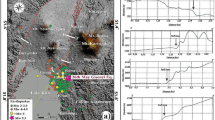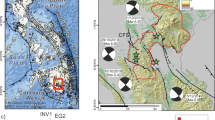Abstract
The Flores earthquake (Mw 7.3) occurred on December 14, 2021, in the Flores Sea and was responsible for an unknown active fault known as the Kalatoa fault. The earthquake's epicenter was located around 100 km north of Flores Island, Indonesia. We analyzed the different earthquake mechanisms using moment tensor (MT) inversion for the mainshock and the largest aftershock with the seismic network at a distance up to 700 km from the epicenter. The results confirm that the mainshock mechanism of the earthquake was NW–SE orientated left-lateral fault with a magnitude estimation Mw of 7.30 ± 0.04 and depth of 9.50 ± 2 km. On the other hand, the aftershock mechanism of the earthquake was NW–NS orientated with a thrusting fault having an Mw of 5.95 ± 0.02 and a depth of 7.5 ± 2 km. The earthquake catalog data from November 2008 to March 2022 are considered in this study to rescale their space–time-depth-magnitude (STDM) time series on a logarithmic scale. Based on the break in time series, we tried to explain the earthquake events as preshocks and aftershocks of the Flores earthquake. Finally, we used wavelet plots of the STDM time series for effective visualization. The localization of lower and high frequency with data points confirms the instant events at which the seismic peak occurred. The outcomes from this study align with the efforts to understand future earthquakes' characteristics elsewhere.







Similar content being viewed by others
Data availability
The datasets analyzed in the current study are available at BMKG earthquake repository (http://repogempa.bmkg.go.id/repo_new/). The seismic waveform data can be accessed from the GEOFON via EIDA (https://geofon.gfz-potsdam.de) and IRIS web services (http://ds.iris.edu/SeismiQuery/).
References
Ansari K (2023) Towards mitigating the effect of plasma bubbles on GPS positioning accuracy through wavelet transformation over Southeast Asian region. Adv Space Res. https://doi.org/10.1016/j.asr.2023.04.041
Ansari K, Park KD (2019) Contemporary deformation and seismicity analysis in Southwest Japan during 2010–2018 based on GNSS measurements. Int J Earth Sci 108(7):2373–2390. https://doi.org/10.1007/s00531-019-01768-w
Ansari K, Bae TS (2021) Clustering analysis of seismicity in the space–time–depth–magnitude domain preceding the 2016 Kumamoto earthquake Southwestern Japan. Int J Earth Sci (Geol Rundsch) 110:253–261. https://doi.org/10.1007/s00531-020-01950-5
Ansari K, Bae TS, Singh KD, Aryal J (2022) Multivariate singular spectrum analysis of seismicity in the space–time-depth-magnitude domain: insight from eastern Nepal and the southern Tibetan Himalaya. J Seismol 26(1):147–166. https://doi.org/10.1007/s10950-021-10057-6
Audley-Charles MG (2004) Ocean trench blocked and obliterated by Banda forearc collision with Australian proximal continental slope. Tectonophysics 389(1–2):65–79. https://doi.org/10.1016/j.tecto.2004.07.048
Azarbad MR, Mosavi MR (2014) A new method to mitigate multipath error in single-frequency GPS receiver with wavelet transform. GPS Solut 18(2):189–198. https://doi.org/10.1007/s10291-013-0320-1
Cesca S, Heimann S, Stammler K, Dahm T (2010) Automated procedure for point and kinematic source inversion at regional distances. J Geophys Res Solid Earth 115(B6). https://doi.org/10.1029/2009JB006450
Curran-Everett D (2018) Explorations in statistics: the log transformation. Adv Physiol Educ 42(2):343–347. https://doi.org/10.1152/advan.00018.2018
Dost B, van Stiphout A, Kühn D, Kortekaas M, Ruigrok E, Heimann S (2020) Probabilistic moment tensor inversion for hydrocarbon-induced seismicity in the Groningen gas field, the Netherlands, part 2: Application. Bull Seismol Soc Am 110(5):2112–2123. https://doi.org/10.1785/0120200076
Gentili S, Di Giovambattista R, Peresan A (2017) Seismic quiescence preceding the 2016 central Italy earthquakes. Phys Earth Planet Inter 272:27–33. https://doi.org/10.1016/j.pepi.2017.09.004
Görgün E (2013) Analysis of the b-values before and after the 23 October 2011 Mw 7.2 Van-Erciş Turkey earthquake. Tectonophysics 603:213–221
Görgün E, Görgün B (2015) Seismicity of the 24 May 2014 Mw 7.0 Aegean Sea earthquake sequence along the North Aegean trough. J Asian Earth Sci 111:459–469
Görgün E, Zang A, Bohnhoff M, Milkereit C, Dresen G (2009) Analysis of Izmit aftershocks 25 days before the November 12th 1999 Düzce earthquake Turkey. Tectonophysics 474(3–4):507–515
Hall R (2002) Cenozoic geological and plate tectonic evolution of SE Asia and the SW Pacific: computer-based reconstructions, model and animations. J Asian Earth Sci 20(4):353–431. https://doi.org/10.1016/S1367-9120(01)00069-4
Heimann S, Vasyura-Bathke H, Sudhaus H, Isken MP, Kriegerowski M, Steinberg A, Dahm T (2019) A Python framework for efficient use of pre-computed Green’s functions in seismological and other physical forward and inverse source problems. Solid Earth 10(6):1921–1935. https://doi.org/10.5194/se-10-1921-2019
Huang Q, Ding X (2012) Spatiotemporal variations of seismic quiescence prior to the 2011 M 9.0 Tohoku earthquake revealed by an improved Region–Time–Length algorithm. Bull Seismol Soc Am 102(4):1878–1883. https://doi.org/10.1785/0120110343
Koulali A, McClusky S, Susilo S, Leonard Y, Cummins P, Tregoning P, Meilano I, Efendi J, Wijanarto AB (2017) The kinematics of crustal deformation in Java from GPS observations: Implications for fault slip partitioning. Earth Planet Sci Lett 458:69–79. https://doi.org/10.1016/j.epsl.2016.10.039
Kühn D, Heimann S, Isken MP, Ruigrok E, Dost B (2020) Probabilistic moment tensor inversion for hydrocarbon-induced seismicity in the Groningen gas field, the Netherlands, part 1: Testing. Bull Seismol Soc Am 110(5):2095–2111. https://doi.org/10.1785/0120200099
Mosavi MR, Azarbad MR (2013) Multipath error mitigation based on wavelet transform in L1 GPS receivers for kinematic applications AEU. Int J Electron Commun 67(10):875–884. https://doi.org/10.1016/j.aeue.2013.04.011
Muksin U, Arifullah A, Simanjuntak AV, Asra N, Muzli M, Wei S, Gunawan Endra, Okubo M (2023) Secondary fault system in Northern Sumatra, evidenced by recent seismicity and geomorphic structure. J Asian Earth Sci 245:105557. https://doi.org/10.1016/j.jseaes.2023.105557
Pasari S, Simanjuntak AVH, Mehta A et al (2021) The Current State of Earthquake Potential on Java Island. Indonesia Pure Appl Geophys 178:2789–2806. https://doi.org/10.1007/s00024-021-02781-4
Simanjuntak AVH, Ansari K (2022) Seismicity clustering of sequence phenomena in the active tectonic system of backthrust Lombok preceding the sequence 2018 earthquakes. Arab J Geosci 15:1730. https://doi.org/10.1007/s12517-022-10973-y
Supendi P, Rawlinson N, Prayitno BS, Widiyantoro S, Simanjuntak A, Palgunadi KH, Kurniawan A, Marliyani GI, Nugraha AD, Daryono D, Anugrah SD (2022) The Kalaotoa Fault: A Newly Identified Fault that Generated the M w 73 Flores Sea Earthquake. Seismic Record 2(3):176–185. https://doi.org/10.1785/0320220015
Wang C, Wang X, Xiu W, Zhang B, Zhang G, Liu P (2020) Characteristics of the seismogenic faults in the 2018 Lombok, Indonesia, earthquake sequence as revealed by inversion of InSAR measurements. Seismol Res Lett 91(2A):733–744. https://doi.org/10.1785/0220190002
Wen YY, Chen CC, Wu YH, Chan CH, Wang YJ, Yeh YL (2016) Spatiotemporal investigation of seismicity and Coulomb stress variations prior to the 2010 ML 64 Jiashian Taiwan earthquake. Geophys Res Lett 43(16):8451–8457. https://doi.org/10.1002/2016GL070633
Acknowledgements
We are grateful to the BMKG for providing the dataset for the analysis and also GEOFON and IRIS for the open access seismic waveform data.
Funding
No funding was received for this study.
Author information
Authors and Affiliations
Contributions
A.V.H. Simanjuntak investigated and written manuscript part and K. Ansari supported to improve the quality of paper.
Corresponding author
Ethics declarations
Ethics approval and consent to participate
Not applicable.
Consent for publication
Not applicable.
Competing interests
The author declares no conflict of interest.
Additional information
Communicated by H. Babaie.
Publisher's note
Springer Nature remains neutral with regard to jurisdictional claims in published maps and institutional affiliations.
Rights and permissions
Springer Nature or its licensor (e.g. a society or other partner) holds exclusive rights to this article under a publishing agreement with the author(s) or other rightsholder(s); author self-archiving of the accepted manuscript version of this article is solely governed by the terms of such publishing agreement and applicable law.
About this article
Cite this article
Simanjuntak, A.V.H., Ansari, K. Spatial time cluster analysis and earthquake mechanism for unknown active fault (Kalatoa fault) in the Flores Sea. Earth Sci Inform 16, 2649–2659 (2023). https://doi.org/10.1007/s12145-023-01067-8
Received:
Accepted:
Published:
Issue Date:
DOI: https://doi.org/10.1007/s12145-023-01067-8




